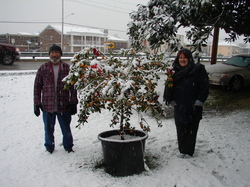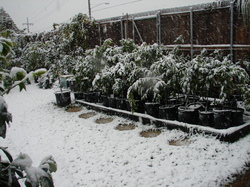Cold Hardy Citrus
Kumquat, Satsuma Mandarin , Calamondin,
INFO ON COLD HARTY CITRUS
Cold weather citrus info-http://www.nola.com/homegarden/index.ssf/2012/11/safeguard_your_citrus_against.html
Cold weather citrus info- http://www.justfruitsandexotics.com/Citrus.htm
Kumquat- http://www.hort.purdue.edu/newcrop/morton/kumquat.html
Kumquat- http://en.wikipedia.org/wiki/Kumquat
Satsuma Mandarin- http://plantanswers.tamu.edu/fruit/satsuma.html
Satsuma Mandarin- http://www.floridata.com/ref/C/citr_ret.cfm
Calamondin- http://www.hort.purdue.edu/newcrop/morton/calamondin.html
Arctic Frost, Orange Frost, Miho, Seto and Bumper are very cold hardy Satsuma trees. All are good to 15 degrees or lower as established trees.
Varieties of Citrus
Citrus varieties vary with cold hardiness, and are
listed below from hardy to tender.
Most Cold Hardy
Kumquats
Satsuma
Sweet Oranges
Navel Oranges
Mandarin
Grapefruit
Tangerines
Tangelo
Lemons
Limes
Tender
The Facts on Cold Hardy Citrus
It was 23 degrees in Metairie the first week of January 2014. All 1 year old trees survived OK. The limes and lemons lost some leaves on the top.
It was 22 degrees in Metairie overnight for 3 nights a few years ago. This is very cold for us. My 10 year od Lime tree lost about 10 percent of its leaves on the north side of the tree and all its blossoms. My 3 year old Meyers lost all it leaves but came back strong in the Spring. No damage to any other citrus trees.
Most people lose their citrus trees in the first or second year of the tree's life. It pays to protect these small trees during 25 degrees F or lower freezes. Here are some things to remember:
- Cover completely with a two-layer combination of a blanket and then plastic. Uncover the next day as it warms up.
- Once established, citrus trees can tolerate lower temperatures and recover more quickly from freezes.
- Keep your tree dormant. Never fertilize after August as this promotes late, tender growth that is susceptible to freeze damage.
- Choose a microclimate. Find an area that's sheltered from northern winds for more tender citrus varieties.
COLD TOLERANCE OF CITRUS
County agents get this question asked often about how cold of a temperature can my citrus tree stand. Citrons, lemons and limes are most easily killed by freezing temperatures. Temperatures in the high 20s will readily kill or severely damage these plants. Sweet oranges and grapefruit are somewhat more cold hardy and usually require temperatures in the mid-20s before incurring major damage to large branches.
Tangerines and mandarins are quite cold hardy, usually withstanding temperatures in the low 20s before incurring significant wood damage. The above information refers to leaf or wood and tree damage. The fruit itself easily freezes at 26-28 degrees that lasts for several hours.
The actual temperature at which tissue of a given plant will freeze and the degree of damage sustained are functions of a number of factors in addition to the species and variety involved. Some of the more important factors include:
- The freezing temperature reached.
- The duration of the freezing temperature.
- How well was the plant hardened or conditioned before freezing temperatures occurred? Were there prior cold snaps before the freezes? Hardened citrus plants may be able to withstand five to six degrees lower than unhardened plants.
- Age of tree. Mature trees often withstand colder temperatures than young trees.
- Healthy trees are more hardy than stressed trees.
Trees growing on bare ground have a higher survival probability than trees growing in turf areas. The heat from the ground can radiate up on bare areas as opposed to being trapped by turf areas. This can be three to five degrees difference in the canopy of the tree.
County agents with the LSU AgCenter recommend you protect your citrus when the temperatures will be below 27 degrees for an extended period of time. This protection is for home-citrus practices generally and you should:
- Cover the entire plant, trying not to touch the foliage.
- Extend the cover all the way to the ground and secure with bricks or other heavy object so wind does not blow it up.
- Cover must be removed when temperatures rise above freezing.
FIG INFORMATION
Figs go dormant every Winter. People who live where it snows grow smaller fig trees, dig them up every Fall, lay them on the ground and cover them with dirt and snow. After the last frost they dig them out, replant, and the tree will make figs year after year.
Figs for commercial and home production in Louisiana is publication No. 1529, and it has all of these varieties in them plus information on how to grow and care for figs.
Barton Joffrion is a county agent with the LSU AgCenter. He can be reached at 873-6495 or bjoffrion@agcenter.lsu.edu. For information, visit the agency’s Web site at www.lsuagcenter.com.
For fig info on the East Coast check out---http://figs4fun.com/bills_figs.html
| We Ain't Afraid of No Cold! Think your area is just too cold to grow citrus? Then try these super cold hardy selections:
|
I sell Calamondins and Kumquats and Olives trees ( 15 degrees) and Lila Avocado ( 15 degrees) and Kiowa Blackberrys (-10 degrees and Goji Berries (-10 degrees).
CONTACT INFO-2032 Pasadena Ave. Metairie,La



